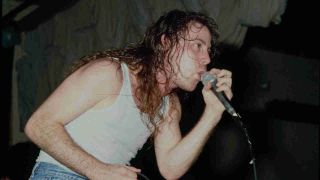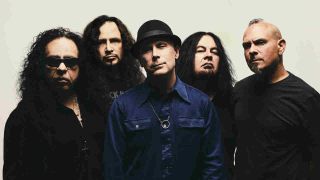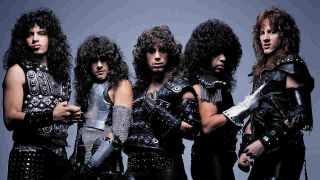By the end of the 1980s, Armored Saint were beginning to wonder if the world was conspiring against them. Formed in Los Angeles in 1982, they had released three widely acclaimed studio albums and become major players in the burgeoning US metal underground. What they definitely hadn’t done was conquer the rest of the world: an oversight vocalist John Bush wearily attributes to the fact that Armored Saint didn’t tour Europe or the UK until much later in their career.
Perhaps surprisingly, then, Bush and his bandmates – bassist Joey Vera, guitarists Dave Prichard and Jeff Duncan and drummer Gonzo Sandoval – were only one year away from recording what would become their biggest and most celebrated album, Symbol Of Salvation. But as they began to contemplate penning a follow-up to 1987’s Raising Fear, all was definitely not rosy in the Armored Saint camp.
“We started writing, and right after that was when we found out about our guitarist Dave Pritchard’s leukaemia.”
John Bush
“We knew we were going to get dropped by our label at the beginning of ’88,” John Bush tells Hammer. “We were going to do another tour but the label withheld tour support and said they weren’t paying for it. So we went out in a van and drove from LA to Syracuse, New York, across the country in January, and it was freezing. One of our fondest memories of that tour was when Dave made this funnel thing to piss in, so you could put the tube outside the window of the van and take a piss, and we wouldn’t have to stop. It was a great idea, but it was also a bad idea! Ha ha ha! We just got piss all over the place. It was funny!”
Despite slumming it across the States with no tour support and a strong chance of frostbite, Armored Saint were buoyed by their last tour of the 80s, which took in shows with both Michael Schenker and Ted Nugent, alongside some sold-out headlining dates. Unfortunately, their efforts would prove to be futile, at least in commercial terms, and an even more devastating bombshell was just around the corner.
“We got home and we officially got dropped, so we didn’t have a label,” John shrugs. “That was the moment when we truly started saying, ‘Right, forget it, we’re just going to write songs and we’re not going to care about anything. We’re just gonna write!’ We weren’t on a label so why we would we look for a particular style, when we don’t know what the future holds anyway? So we started writing, and right after that was when we found out about Dave’s illness with leukaemia.”
Not just an insanely gifted lead guitarist but, as Bush notes, the most natural leader in Armored Saint at the time, Dave Prichard had discovered that he had leukaemia after taking a blood test to assess his suitability for a powerful acne medication.

“That was a death sentence in the 80s, it was a pretty severe form of cancer,” John says. “They’ve made a lot of strides with leukaemia now, but back then it was pretty bad. So his illness, the band being dropped and our whole future being so uncertain, that was all what propelled us towards just writing songs and not worrying if something was totally out of the box compared to what Armored Saint usually did. And that’s where songs like Last Train Home came from.”
Dave Prichard passed away on February 28, 1990, midway through writing sessions for the new Armored Saint album. The band took several months to mourn their friend and to work out exactly how to proceed, but it soon became apparent that the sheer strength of the material that they had been writing compelled them to move forward and make a new album. With Gonzo’s brother (and original member) Phil rejoining the band on rhythm guitar, the retooled Armored Saint had kept things very much in the family. Significantly, the band’s line-up remains exactly the same today.
“That family feeling is super-important to this band – even though I know that we made Symbol… and then I left the band and joined Anthrax! Ha ha ha!” John says. “It kind of ended for a while, but we got back together and made Revelation [released in 2000] and we’ve continued on as the same guys, so it’s always been like a family, for better or worse. Families sometimes have a little conflict here and there, but it’s still a family. Back in 1990, we knew that that was how we were going to get through it.”
Symbol Of Salvation was released on May 14, 1991, through Armored Saint’s new home of Metal Blade Records. A 55-minute hard rock and heavy metal tour de force, it sounded like the work of band truly hitting their creative stride, with everything from skull-rattling thrash to trippy, blues-tinged ballads hurled into the mix. One song immediately stood out, however: the titanic, heart-rending melodic feast of Last Train Home. Written toward the end of writing sessions for Symbol Of Salvation, the song was not a direct tribute to Dave Prichard, but its lyrics seem unbearably poignant in light of his untimely passing: ‘Crossroads of my life / Feel my body glide / To a place I need to be / It’s within my sights / When I get there I’ll be free…’
“Maybe it’s in there subliminally,” John suggests. “At that time, what I’d sometimes do is just babble over things to try and get a melody. It would sound like I was saying words but I really wasn’t, I was just trying to get the melody across. For some reason, whether it was my idea or somebody else’s, we were playing that song and trying to write it and the lyrics just came out. I sang ‘Last train home…’ and just repeated it. That sounded like a cool title and it just happened. Not to get too spiritual about it, but it seemed very organic. Then the lyrics took shape.”
Not just the catchiest and most anthemic song on an album full of wildly dynamic moments, Last Train Home also seemed to be a major milestone in the evolution of the Armored Saint sound. While the band’s first three records had been largely rooted in traditional metal, with a strong and obvious influence from Sabbath and Priest, their fourth was incredibly diverse and fervently contemporary. With its unapologetic pop sensibilities, Last Train Home was a significant detour for the former trad metal diehards. Thirty years later, it’s the band’s biggest song, from an album that remains their most definitive work.
“Don’t get me wrong, I love the first three records,” states John. “Delirious Nomad [1985] was like the mischievous kid, March [Of The Saint, 1984] set it all up and Raising Fear [1987] has some great moments as well, but I don’t think we really hit our stride until Symbol…, and that opened the door to what followed. Suddenly we had a lot more security about our identity. We weren’t thrash, we weren’t a hair band, we were a hard rock band and we could play Mad House [from March Of The Saint], which bordered on thrash, and then we’d have a moody ballad like Isolation [from Raising Fear], so we were always all over the place. In retrospect, I like it all. We were experimental, but it was because we didn’t know what we were doing, and that’s the truth!”

Armored Saint played Symbol Of Salvation live in its entirety as recently as 2018, and John Bush grins at the memory of the crowd response every night, particularly during Last Train Home. As he notes wistfully that he can’t wait to get back on the road and play songs from Armored Saint’s excellent new album, Punching The Sky, to an increasingly broad and passionate fanbase, John Bush also admits that his band may struggle to ever write a song that hits the emotional bull’s-eye with quite the same ferocity as Last Train Home. Although memories of the making of Symbol Of Salvation will always be tinged with great sadness, the songs that came out of those tough times have sustained Armored Saint through many decades.
“Oh man, Last Train Home has a huge chorus and it’s easy for people to sing along to!” he beams. “It’s certainly a moody track and it’s explosive at the same time. It has a cool breakdown that people really seem to get drawn into and then it ends with another big chorus. But it’s a hard song to sing! There are some high notes in there. My voice is very different from how it was in 1991, so sometimes it’s an opportunity for me to stick the mic out there for the crowd, because I really need a breath! Ha ha ha!”


